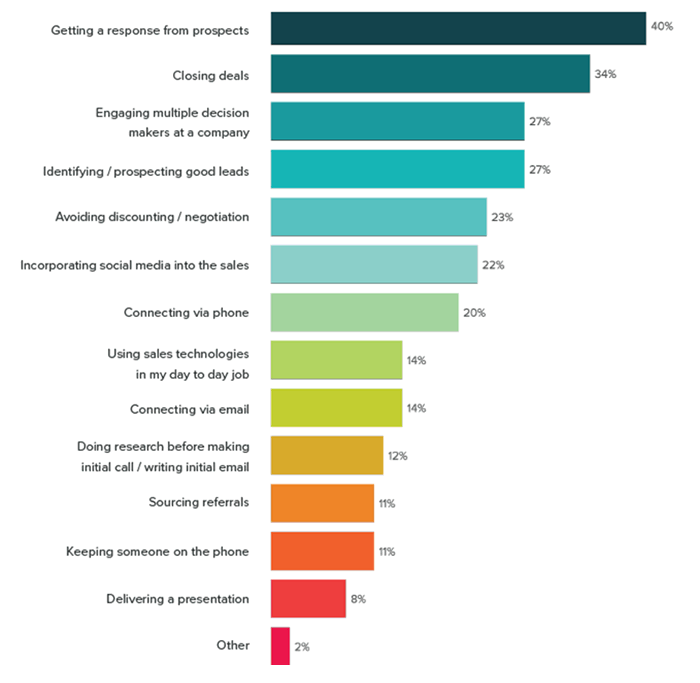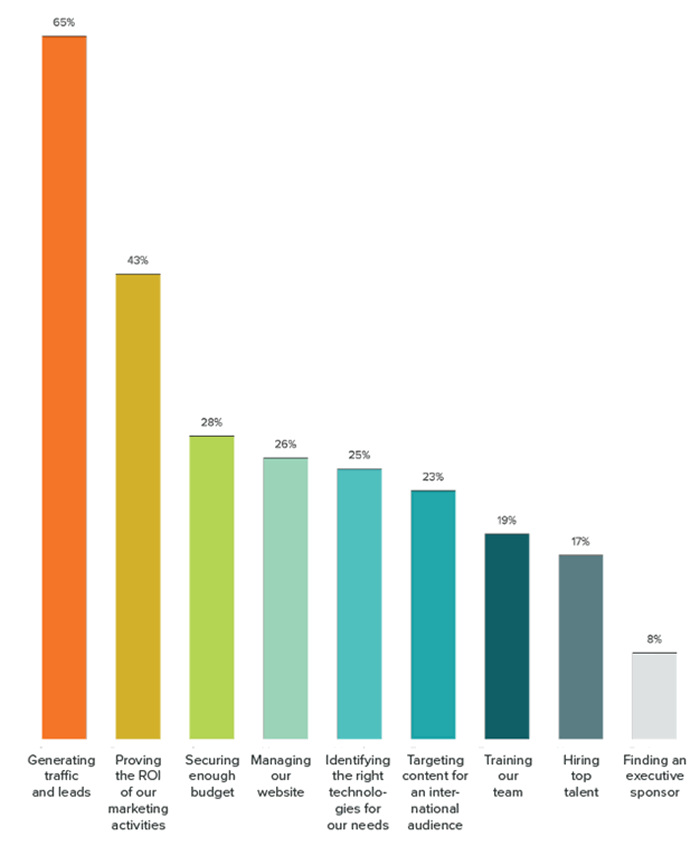Improving Sales and Marketing Alignment: New Data Reveals Sales' New Top Concerns

When it comes to sales and marketing alignment, there’s a lot of buzz around the need for marketing to deliver higher quality leads to sales teams.
But new data suggests we might be buzzing in the wrong places; it turns out only 17% of sales people say they’re concerned about the quality of their leads.
What, then, are sales people concerned about, and how can marketing help? We’ll explain both below.
The different challenges between sales and marketing
The data from HubSpot’s 2016 State of Inbound Marketing report is in – and the insights are both surprising and helpful.
Nominally, both sales and marketing are concerned about driving more revenue to the bottom line: 74% of marketers say they’re most focused on converting more contacts and leads into customers, while 70% of sales teams say they’re most focused on closing more deals.
Sounds like they’re focused on the same things, right? Maybe not.
When we look at the top challenges both sides experience, a different picture emerges.
What is more difficult to do in sales compared to 2 to 3 years ago?

Clearly, sales is struggling to connect with prospects – from simply getting prospects to respond, to engaging with decision makers, leveraging social media/email/phone and more.
Marketing, however, is more distracted with top-of-funnel and internal challenges.
What are your company’s top marketing challenges?

See the difference?
What sales desperately needs is help making connections with prospects, so they can ultimately close more deals.
Fortunately, there’s a lot marketing can do to help. Below, we've spelled out our top five suggestions.
Related Content: What Is Inbound Marketing All About, Anyway?
5 ways to improve sales and marketing alignment
Set goals together
Better alignment starts with better integration. This means sales and marketing need to sit at the same table during planning sessions. This is the best way to ensure both sides are setting goals that are realistic and actionable.
 For example, if sales decides they want to triple sales in the next quarter, marketing needs the opportunity to let them know that just ain’t gonna happen. The two sides can then work together to set more appropriate targets.
For example, if sales decides they want to triple sales in the next quarter, marketing needs the opportunity to let them know that just ain’t gonna happen. The two sides can then work together to set more appropriate targets.
On the other hand, if sales is focused on pushing a specific product line next quarter, marketing can build a content strategy around that goal.
Similarly, if marketing is creating a campaign around a specific theme, keeping sales in the loop ensures reps can align their communications. For example, if marketing wants to promote an event, sales reps should be mentioning this event in conversations with buyers.
With the right support, both teams stand a better shot at hitting their numbers.
Invest in social selling
 According to HubSpot’s data, 42% of buyers communicate via social networks such as LinkedIn and Twitter for business purposes. Don’t neglect these social channels when trying to connect with buyers!
According to HubSpot’s data, 42% of buyers communicate via social networks such as LinkedIn and Twitter for business purposes. Don’t neglect these social channels when trying to connect with buyers!
But being part of the social scene doesn’t happen by accident. Make sure your sales team is equipped with the right tools to monitor conversations and respond at the right times. Train reps on best practices for finding interested buyers, sending personalized messages, and leveraging the unique quirks of each social media platform.
 Think social selling doesn’t require investment? CSO Insights reports that win rates can be improved by 38% and sales quota attainment by a whopping 51% when sales teams are properly trained.
Think social selling doesn’t require investment? CSO Insights reports that win rates can be improved by 38% and sales quota attainment by a whopping 51% when sales teams are properly trained.
Interestingly, HubSpot’s report also shows that the number one things sales people look for in a new job is the opportunity to grow. Investing in social selling may not only be the right move for increasing revenue, it may help you attract and retain higher-performing sales people as well.
Be smarter with your CRM
Without a platform for data sharing and communication, sales and marketing alignment becomes all but impossible.
![]() But it’s not just about having a great database of leads – it’s about setting up the CRM system to provide the right information at the right time.
But it’s not just about having a great database of leads – it’s about setting up the CRM system to provide the right information at the right time.
As many as 44.6% of sales reps need help recognizing potential buying signals. Marketers can reduce this gap by setting up real-time alerts so that reps know the right moment to reach out to a prospect.
This means taking the time up front to sit down with the sales team and identify all of the buyer activities that might indicate a sales-ready lead. For instance, clicking on an email like might trigger one type of sales response while downloading an ebook might trigger another.
Make better content that’s easier to find
According to KnowledgeTree, 95% of B2B purchase decisions are directly influenced by content. And yet, up to 30% of a sales rep’s time is spent looking for, customizing, or creating content from scratch.
 Content sells – IF the content has been produced strategically and IF the sales team knows how to find and use what they need.
Content sells – IF the content has been produced strategically and IF the sales team knows how to find and use what they need.
First, make sure you’re producing content that’s relevant. Sit in on a few sales calls so you can see first-hand the questions and obstacles sales reps must overcome. Use that insight to create a range of content assets, from short-form pieces like blogs and infographics to deeper-dive resources like ebooks, slide decks and interactive brochures.
Next, make sure your content library is well documented. A simple Google Doc may be all it takes. Index your content assets according to buyer type, buying stage, product, and content type. Include links to each content asset, so that reps can quickly and easily grab what they need with the click of a button.
And finally, make sure these assets are connected within your CRM, so that reps know when their leads visit specific landing pages or download specific assets.
Look at data together
While setting goals together is important at the start of the planning process, close the loop by looking at your results together as well.
Both sides of the table have access to great analytics, and sharing that data keeps everyone equipped to continually optimize.
 For starters, marketing needs to know which leads actually become customers. How did these leads first connect with your company? What content did these leads consume? What emails did leads open? How did these leads interact with both marketing and sales during the buying process? How does that behavior differ in leads that don’t close?
For starters, marketing needs to know which leads actually become customers. How did these leads first connect with your company? What content did these leads consume? What emails did leads open? How did these leads interact with both marketing and sales during the buying process? How does that behavior differ in leads that don’t close?
And most importantly, how can you use this information to improve what you’re doing?
Find out what’s working, and do more of it. Find out what’s not working, and either fix it or stop it.
Ultimately, the best approach to sales and marketing alignment all boils down to one thing: keeping the lines of communication open, so that both teams are working toward the same common goals.
With the right priorities solidly in place, both sides will have the support they need to achieve every target they’ve set.




![Great Sales Emails That Convert [TEMPLATES]](https://www.clariantcreative.com/hubfs/blog-images-2018/email-templates.jpg)